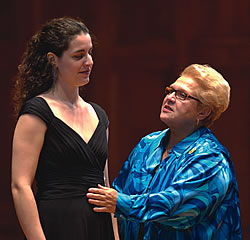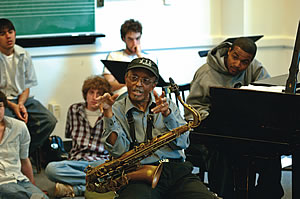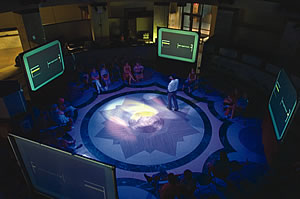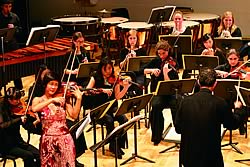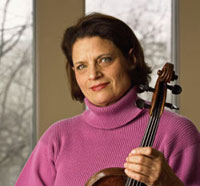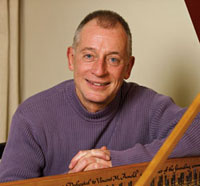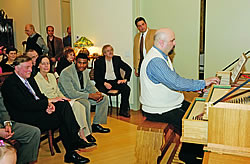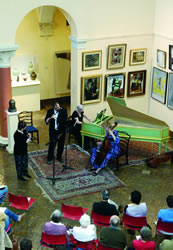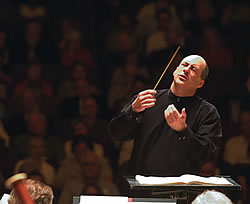

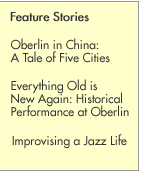 |
|
Home :: Of Note Of Note :: From the Top with Maestro Spano at Carnegie Hall From the Top with Maestro Spano at Carnegie Hall
Members of the Oberlin Conservatory Symphony Orchestra will have plenty to write home about this January. Conductor Robert Spano ’83, Music Director of the Atlanta Symphony Orchestra (ASO) and Professor of Conducting at the Conservatory, will be in residence that month, preparing them for a performance at Carnegie Hall. Spano will lead the orchestra in a program that includes Jennifer Higdon’s blue cathedral, Mozart’s Piano Concerto No. 25 in C Major, K. 503 (featuring the pianist Pedja Muzijevic as guest soloist), and Bartók’s Concerto for Orchestra. Recognized internationally as one of the brightest and most imaginative conductors of his generation, Spano’s innovative programming has enriched and expanded the ASO’s repertoire. He joined the ASO after eight years as Music Director of the Brooklyn Philharmonic, where he also made his mark, leaving it at a new level of international prominence. (His successor at the Brooklyn Phil is Michael Christie ’96, who studied with him as an Oberlin student.) “All of us at Oberlin eagerly look forward to Maestro Spano’s presence on campus,” says Dean of the Conservatory David H. Stull. “His gifted leadership of young orchestras is legendary, and he has a unique ability to inspire young musicians to transcend their capacity.” Although technically a piano major at Oberlin, Spano did study conducting here as well. His ruminations on the art can be found in the August 21 issue of the New Yorker magazine, in which he served as music critic Justin Davidson’s guide through its mysteries and methods. Bosnian-born pianist Pedja Muzijevic is making his Carnegie Hall debut with this performance. He previously shared the stage with Spano during a concert of Hungarian music at the Brooklyn Academy of Music Opera House in 1998. A free performance of the Spano-led concert takes place in Oberlin on Wednesday, January 24, 2007, at 8 p.m. in Finney Chapel. Tickets for the Carnegie Hall performance on Friday, January 26, 2007, at 8 p.m. are available by phoning the Carnegie Hall box office at 212-247-7800. Corporate sponsorship of these concerts is provided by the DeWitt Stern Group. Marilyn Horne proved that star power is more than aura or mystique when she arrived in Oberlin for a four-day residency last October. The famed mezzo-soprano, who is Visiting Distinguished Professor of Voice in the Conservatory, worked with students privately and in public master classes.
“For me, the best part was seeing her obvious enthusiasm for the future of singing, and her forthright demands that the students work as close to perfection as possible,” says Professor of Singing and Director of the Vocal Division Gerald Crawford. Edward Parks ’06, a 22-year-old baritone from Indiana, Pennsylvania, sang the aria Ah, per sempre io ti perdei from the opera I Puritani by Vincenzo Bellini, a composer close to Horne’s heart. Horne is widely credited with helping to restore the prominence of bel canto operas, such as those by Bellini, and incorporating the operas of Handel into the mainstream repertoire. “She told me I was holding back my sound,” Parks said afterwards. “She worked on bringing it forward—something I had been working on—but she helped me understand how it should sound in my head. The way you hear yourself in your head is not how everyone else hears you.” “Don’t be afraid to sound ugly to yourself,” she told Parks, “because to us you don’t sound ugly. It sounds right.” Megan Hart ’06, a 22-year-old soprano from Eugene, Oregon, sang Mozart’s Come scoglio for Horne. “She helped me feel like I could take risks with the music,” Hart says. “When you watch her, you see that it makes a difference. From now on, I am not going to be afraid to individualize my performances. I won’t be afraid to take liberties, if the score permits them.” Dean of the Conservatory David H. Stull coordinated Horne’s residency with help from Associate Professor of Voice Salvatore Champagne and with financial support from the Danenberg Residency Fund. Stull has made plans for Horne’s return October 27 to 30, 2006. Also on October 30, Peruvian tenor Juan Diego Flórez will perform in the Artist Recital Series, thus making Oberlin the place to be that weekend for opera lovers. “Marilyn Horne is an extraordinary teacher. She is able to transform students in a very short period of time,” Stull says. “She’s an example of a great artist who is also a great teacher. Her teaching and artistry transcend her fame, which is a significant thing to say.” Horne made it clear that she, too, got something out of her residency at Oberlin. “I love being here with all these young people who are so talented,” she said. “Obviously, there’s some really good teaching going on here. Celebrated oboist Alex Klein ’87, AD ’89 was the guest soloist for an Oberlin Chamber Orchestra concert at Cleveland’s Severance Hall in April. A poignant performance for Klein, the concert was dedicated to the memory of Professor of Oboe James B. Caldwell, Klein’s Oberlin professor and mentor. One of the world’s most respected and admired oboists, educators, and proponents of early music, Caldwell died in February of lung cancer. The concert was conducted by Music Director of the Oberlin Orchestras Bridget-Michaele Reischl and marked her Severance Hall debut. The program featured Michael Gandolfi’s Impressions from ‘The Garden of Cosmic Speculation,’ Strauss’s Concerto for Oboe and Small Orchestra in D-Major, and Beethoven’s Symphony No. 7 in A Major, Op. 92. A live broadcast of the performance on 104.9 FM-WCLV, Cleveland’s classical station, along with a simulcast on www.wclv.com, was made possible with the support of the Riverside Company. In his review of the performance, Plain Dealer music critic Donald Rosenberg wrote, “Superb musicians seem to pour out of Oberlin as easily as water from a mountain spring. ... Look for more than a few of these players on the world’s major stages in coming decades.” Two decades ago Professor Caldwell’s student Alex Klein was just such an Oberlin musician, poised to embark on the career that continues to take him to the world’s major stages. The recipient of numerous international prizes, including the 2002 Grammy Award for Best Instrumental Soloist with Orchestra, Klein was principal oboe of the Chicago Symphony from 1995 to 2004. Klein now conducts, plays solo concertos, and directs the Officina de Musica Festival in Curitiba, Brazil, and other music festivals around the world. “James Caldwell ... saw joy and beauty in every millimeter of life,” says Klein, “and he brought his vast knowledge and experience into the practice of his teaching. I am sorry for the generations of musicians who will not have the opportunity to study with him.” Caldwell joined the Conservatory faculty in 1971. A year later, he and his wife, Associate Professor of Cello, Viola da Gamba, and Baroque Cello Catharina Meints, founded Oberlin’s renowned Baroque Performance Institute (BPI), the first summer institute in the United States dedicated to the study and performance of music on period instruments. BPI remains America’s premier summer workshop for baroque instruments and voice. “James Caldwell’s professional accomplishments cannot be measured at this point in our history,” says Dean of the Conservatory David H. Stull. “His reach into the world of music and art will be felt for generations to come. He was an integral part of Oberlin, and his profound work as an artist and teacher, conjoined with his intellectual capacity and unlimited curiosity, served to help shape the ideals we prize most at our Conservatory.”
Guest artists enhanced the Conservatory of Music’s musical life during the 2005-06 academic year with master classes, performances, and presentations. Visiting under the auspices of Oberlin’s renowned Artist Recital Series were pianist Richard Goode, the Miró String Quartet, the chamber orchestra I Musici de Montréal, the King’s Singers, violinist Nadja Salerno-Sonnenberg and pianist Anne-Marie McDermott, jazz innovator Wayne Shorter and his eponymous quartet, and the percussion ensemble Kroumata. The series closed with the Cleveland Orchestra’s 204th Oberlin appearance; Donald Runnicles conducted the orchestra in a program that featured violinist William Preucil. Two of the series’ concerts were broadcast on 104.9 WCLV, northeast Ohio’s classical music station: the King’s Singers performance was broadcast live, and the Miró String Quartet’s performance was broadcast May 26. Broadcasts of Oberlin concerts on WCLV are made possible by the sponsorship of the Riverside Company, a leading private equity firm specializing in premier companies. Among the other artists to visit Oberlin during the 2005-06 academic year was Charles Schlueter, principal trumpet of the Boston Symphony Orchestra, who presented a master class and recital in which pianist Deborah DeWolf Emery ’74 performed. Jeannette Sorrell AD ’90 brought her acclaimed baroque orchestra, Apollo’s Fire, to Finney Chapel in February. She returned in March to conduct the Oberlin Baroque Orchestra, a 32-member student ensemble that performs on period instruments from the Conservatory’s renowned collection. Oberlin hosted several jazz legends during the year, including jazz/folk bassist Bill Lee. During a four-day residency, Lee worked with three student combos and presented a concert with them. Trombonist Slide Hampton spent three days on campus teaching master classes and performing in concert with the Oberlin Jazz Ensemble (OJE). Saxophonist Jimmy Heath also performed with the OJE, along with guest vocalist Janice Reddick ’04. Heath also led an improvisation workshop during his visit. The Berlin-based performance-art ensemble Die Audio Gruppe worked with Oberlin students during a two-day residency that culminated in a performance in the Lewis Center for Environmental Studies. Robert Sherman and his son Steve J. Sherman ’81 made separate presentations to Kathleen Chastain’s Professional Development for Musicians class. Writer, teacher, and radio personality Robert Sherman is senior consultant for WQXR 96.3FM, the classical music radio station of the New York Times, for which he hosts several programs, including the McGraw-Hill Young Artists Showcase. Prominent New York City performing-arts photographer Steve J. Sherman has served as a principal and/or official photographer for numerous organizations, including Carnegie Hall, the Lincoln Center, and the New York Philharmonic. During the 2005-06 season, Oberlin students headlined or participated in performances throughout the country and abroad. In February, Oberlin accepted its second consecutive invitation to participate in the Kennedy Center for the Performing Arts’ Conservatory Project Series. Both the 2006 and the 2005 Oberlin concerts can be viewed on the Kennedy Center’s web site, www.kennedy-center.org/programs/ millennium/archive.html#search. Five groups of students performed in 2006: mezzo-soprano Katherine Lerner ’06, viola da gambist Zoe Weiss ’07, and harpsichordist Benjamin Katz ’08; pianist Megan Glover ’06 accompanying soprano Megan Hart ’05, MM ’06 and horn player and performance diploma candidate Jorge Mejia in separate performances; the Oberlin Jazz Septet; and the Prima Trio—clarinetist Boris Allakhverdyan ’08, violinist Farhad Hudiyev ’08, and pianist Anastasia Dedik ’06. In October 2005, the Prima Trio opened the fifth season of the popular Oberlin at Oakton music series, which was founded by the late William R. Perlik ’48, an honorary trustee and former chair of the Board of Trustees, and his wife, Annabel Perlik ’49. In April, an Oberlin contingent was a featured part of the Florida Electroacoustic Music Festival. The members of the group were Assistant Professor of Computer Music and Digital Arts Tom Lopez, Assistant Professor of Composition Ross Feller, and five students: Katelyn Mueller ’07, Patrick Barter ’06, Michael Geraci ’07, Amrita Dang ’06, and Jacob Gotlib ’07. Earlier, in September 2005, Gotlib’s composition Filaments was performed by the California EAR Unit during the opening concert of the group’s premiere season at the Roy and Edna Disney/CalArts Theater (REDCAT). In May 2005, the contemporary classical music ensemble Reach Fusion took to the road in an effort to help the Alzheimer’s Association. The student group’s One Small Step tour covered five northern Ohio cities and Quincy, Ill. Reach Fusion includes violist Anne Ristorcelli ’07, pianist SeungKu Lee ’06, and percussionists Michael Lehman ’06 and Aaron Williams ’07.
The Cleveland Connection The OJS performed in the city’s Arts Renaissance Tremont series in February, and it was one of six groups of Oberlin students taking part throughout the year in Trinity Cathedral’s Brownbag Concerts Series; the others were the Jasper String Quartet; mezzo-soprano Katherine Lerner ’06 and baritone Edward Parks ’06; harpists Erin Ponto ’06 and Sarah Oliver ’06; the Oberlin Percussion Group, directed by Professor of Percussion Michael Rosen; and the Oberlin Collegium Musicum, directed by Professor of Musicology Steven Plank. The Oberlin College Choir, directed by Associate Professor of Choral Conducting Hugh Floyd, joined the Kronos Quartet in a multimedia concert experience at Cleveland’s Masonic Temple and Performing Arts Center in February. The concert featured Terry Riley’s Sun Rings, a fusion of choral music, electronic sounds from outer space, and visual projections from the Milky Way.
In the Big Apple In April, the CME presented two world premieres at Merkin Concert Hall: Jason Eckardt’s Trespass, which it commissioned, and St. Francis Preaches to the Birds by Professor of Composition Lewis Nielson. Eckardt dedicated Trespass to pianist Marilyn Nonken, who performed the work at all three concerts and served a residency at Oberlin. Nielson dedicated his work to violinist J Freivogel ’06, who appeared as soloist. The CME also performed Apparitions, composed in 2003 and revised in 2006 by Professor of Composition and Music Theory Randolph Coleman. Oberlin Welcomes New Faculty Members
The Conservatory welcomed two new faculty members at the beginning of the 2005-06 academic year: Karen Ritscher, Associate Professor of Viola, and Webb Wiggins, Associate Professor of Harpsichord. A graduate of both the bachelor’s and master’s programs at the Eastman School of Music, Ritscher has served as principal violist for the Dallas Opera and the Houston Grand Opera. She has performed regularly with the Orchestra of St. Luke’s, the Orpheus Chamber Orchestra, the Aureus Piano Quartet, and the Azure Ensemble, and has held appointments at many music festivals. She has taught at the Karen Tuttle Coordination Workshop since 2002, and has held master classes throughout the country and abroad. Ritscher has commissioned and premiered works by several contemporary composers, and she recently recorded Ernest Bloch’s complete works for viola and piano. A past board member of the American Viola Society, Ritscher is the education editor for the Journal of the American Viola Society and author of the column “In the Studio.” Wiggins is no stranger to Oberlin. A specialist in harpsichord, continuo, and chamber music, he was a visiting professor in 1993-94 and has been a faculty member of the Oberlin Baroque Performance Institute since 1985. He holds a bachelor’s degree from Stetson University and a master’s degree from the Eastman School of Music. He also has studied at the Sweelinck Conservatory in Amsterdam. A faculty member at the Peabody Conservatory of Music from 1986 to 2005, Wiggins coordinated the early music program and was musical director of baroque operas there. He was assistant to the director of the chamber music program at the Smithsonian Institution from 1985 to 1989, where he maintains an active performance and teaching relationship. Wiggins has performed as a soloist throughout the world and has played and recorded with such ensembles as Apollo’s Fire, the Baltimore Consort, and the Atlanta Symphony Orchestra. He has recorded on the Dorian, EMI, Bard, Smithsonian, and PGM record labels. Faculty appointments for the 2006-07 academic year were announced recently by Dean of the Conservatory David H. Stull. More information about these faculty members will appear in the 2007 issue of Oberlin Conservatory. Instrument Collection Enhanced by New Acquisitions The Conservatory has added two new instruments to its already enviable collection: a five-octave fortepiano and a pedal clavichord. The pedal clavichord, one of only a few such instruments in the United States, is a gift to Oberlin from organ alumni James David Christie ’74, John Finney ’78, and Frederick Haas ’83 in honor of Professor of Organ David Boe. The instrument was presented during a surprise 70th birthday party for Boe in March 2006.
Oberlin’s pedal clavichord was built in Sweden by Joel Speerstra ’89, who is head of the Clavichord Research Workshop at Göteborg University and author of Bach and the Pedal Clavichord, which documents his research on keyboard instruments directly related to the organ. “One of the motivations of the research into these instruments has been to better understand why Bach used clavichords in his teaching for organ students,” says Speerstra. The pedal clavichord was prized by 18th-century organists for its sensitivity, respected for its difficulty, and considered the ideal tool for learning to play the organ. It is “the perfect instrument for learning about touch and control,” says Christie, who is Professor of Organ at Oberlin. “Oberlin’s organ students will find it incredibly helpful in learning how to really listen to detail and to start to think about how they play every note, how they sit at the instrument, and how they move their bodies when they have to shift to a different position for the pedals.” Speerstra modeled the instrument after the only surviving 18th-century model, which was built in 1766 by Johann David Gerstenberg and is now housed in Leipzig University’s instrument museum. Oberlin’s new fortepiano was built by Paul McNulty and based on a circa 1792 instrument by Anton Walter, who was among the most renowned Viennese builders. Mozart owned a Walter instrument, and Beethoven wanted one, but Walter would not meet his price. McNulty’s shop is located in Divisov, Czech Republic, about 30 miles outside of Prague, giving him ready access to wood from the same forests that supplied the piano trade in Vienna 200 years ago. Before obtaining the McNulty, the Conservatory owned three fortepianos, including five-octave instruments by Hester and Wolf and a six-and-a-half octave by McCobb. “When the Conservatory purchased a Hester fortepiano in the early 1980s, we were already ahead of the curve in building a historical instrument collection,” says David Breitman, Associate Professor of Historical Performance and Director of the Historical Performance Program. “The McNulty instrument, like the Hester, is based on an original by Anton Walter. It offers a greater variety of sound and it’s louder, which makes it more useful in chamber music. Since the first modern forte-pianos were constructed, the art of building reproductions has advanced considerably, and an institution of Oberlin’s caliber deserves to have the state-of-the-art.” Others in the Conservatory agree. “We work hard to constantly increase the quality of our instruments through strategic purchases and donations,” says Michael Lynn, Oberlin’s Associate Dean of Technology and Facilities, Professor of Recorder and Baroque Flute, and Curator of Musical Instruments. “At the heart of any great music school is its faculty and students,” says David H. Stull, Dean of the Conservatory, “but in order to have great music, you need great instruments to realize the full imagination of the musicians. Oberlin is quite fortunate to have one of the world’s greatest instrument collections, which includes such extraordinary instruments as a Stradivarius violin and two Gagliano violins.” Oberlin owns more than 1,500 instruments, including what can safely be considered the nation’s foremost collection of historical instruments and its finest organ collection, says Lynn. Oberlin has one of the world’s largest collections of Steinway pianos—nearly 200—and outstanding collections of orchestral and non-Western instruments. “Our collection exists entirely to benefit students,” says Lynn. “Rather than being a collection in the museum sense, ours is more like a lending library. The quality of the instruments determines what a musician can get out of them, and since we work with students of the highest caliber, our instruments also must be excellent.” For the Record: Eubanks Wins a Grammy Associate Professor of Jazz Trombone Robin Eubanks won a 2005 Grammy Award for his work with the Dave Holland Big Band on the album Overtime. The recording, which won the category for Best Large Jazz Ensemble Album, features one of Eubanks’s compositions, Mental Images. Called a “master manipulator of the valve horn” by High Bias magazine, Eubanks has been credited by the Philadelphia Inquirer for transforming the trombone from “an aging relic of big-band days into a youthful augur of the future.” In October 2006, the Conservatory plans to release The Oberlin Orchestra in China, a recording made during the Oberlin Orchestra’s winter 2005-06 tour of China. Building Castles in the Sky, a retrospective of late Professor of Oboe James Caldwell’s career, was released by Boston Records in March 2006. The CD features Caldwell’s art work and program notes by his wife, Associate Professor of Cello, Viola da Gamba, and Baroque Cello Catharina Meints, and it includes Caldwell’s 1987 world-premiere performance with the Cleveland Chamber Symphony of Walter Aschaffenburg’s Concerto for Oboe and Orchestra, Op. 25. Oberlin faculty members continue to contribute to Bridge Records’ Complete George Crumb Edition. Volume 6 features Professor of Piano Robert Shannon and Professor of Violin Gregory Fulkerson. The two performed together on Four Nocturnes, and Shannon recorded Gnomic Variations. Shannon went on to record Makrokosmos, Volumes I and II, for the edition’s Volume 8, an effort that elicited this praise from the online music magazine Splendid: “ ... he is an eloquent and powerful pianist. The amplified piano makes a panoply of sounds over the course of the disc, some derived from playing within the instrument and others from playing the keys in a more traditional manner.” Associate Professor of Historical Performance David Breitman, who also directs the Historical Performance Program, and violinist Jean-François Rivest have been recording the complete Mozart sonatas for fortepiano and violin for the Analekta label. Volume 2 was released in January 2005. Jed Distler of ClassicsToday.com says that this volume “may well surpass Volume 1’s high artistic and sonic standards,” and that “collectors seeking a period-instrument Mozart piano and violin cycle will gain lasting satisfaction from this first-rate release.” At the invitation of the French flute association La Traversière, Professor of Flute and Performance Michel Debost has recorded a fourth volume in his Flute Panorama CD collection on the Skarbo label: Volume 4, Panorama Pour Flûte et Orchestre. The CD showcases works by 20th-century French and American composers. “ ... as perfect as his playing is, Debost is no automaton. ... He is living, breathing music, thrilling and intense,” says the San Francisco Chronicle. Archived recordings of flutist Robert Willoughby, the first Robert Wheeler Professor of Performance at Oberlin, have recently been released as part of the National Flute Association’s Historic Recording Series. “The Willoughby legacy continues to flourish, not only through his ongoing teaching but also through the teaching and performing of his students,” writes Danielle Hundley in the liner notes. The recording features solo flute and chamber music by C.P.E. Bach, Debussy, Hindemith, Ibert, Telemann, and others. All but one of the musicians featured on the recording are current, emeritus, or former professors at the Conservatory. Two recently released CDs feature Oberlin student musicians. The third volume of the student recording series Aural Capacity was released in 2005 and features 12 musicians from the Conservatory’s composition, jazz, and TIMARA departments. Before he graduated in May 2005, guitarist Max Hellerman recorded his tune Solar Bingers with the Oberlin Jazz Septet. The recording was featured in the October 2005 edition of Jazziz on Disc, a limited edition collector’s CD released monthly inside subscriber copies of Jazziz magazine. Music History Professor Claudia Macdonald examines the lasting effect that Robert Schumann has had on the piano concerto in her book, Robert Schumann and the Piano Concerto, which was published by Routledge last August. Macdonald relates Schumann’s compositional evolution to his musical environment: an exhilarating atmosphere in which he and his contemporaries reshaped and refined the concept of concerto style. Rolling Stone Decrees: Oberlin Rocks While long recognized as one of the world’s preeminent professional training institutions for serious musicians, Oberlin has also topped the list of “schools that rock.” An article in the August 11, 2005, issue of Rolling Stone magazine called Oberlin “home to one of the best music conservatories in the U.S.” The ranking is culled from Rolling Stone’s college guidebook, Schools That Rock: The Rolling Stone College Guide (Wenner Books), published last year. Happy Birthday, Wolfgang and Johann The birthdays of two musical giants, Wolfgang Amadeus Mozart and Johann Sebastian Bach, were celebrated on campus in true Oberlin style—with music and scholarly exploration. Open to members of both the College of Arts and Sciences and the Conservatory of Music, the interdisciplinary winter-term symposium, the Mozart Experience, celebrated the 250th anniversary of Mozart’s birth—January 27, 2006—with a month-long series of lectures, discussions, and films. The symposium culminated in a chamber-music marathon and a production of one of Mozart’s best-loved operas, Così fan Tutte. Two months later, the Oberlin community turned out to fete the memory of J.S. Bach on what would have been his 321st birthday—March 21, 2006. The celebration was held in Warner Concert Hall and featured the composer’s organ and chamber music with commentary by Professor of Musicology Steven Plank. Seven organ soloists and two historical performance chamber groups featuring organ, harpsichord, cello, violin, recorder, and vocals performed arias, fugues, and various preludes. Michael Barone ’68, senior executive producer at Minnesota Public Radio and host of American Public Media’s radio program Pipedreams, hosted the event, which was broadcast live on Cleveland’s classical station WCLV. Museum Show Melds Music and Art
Experiencing one art form can heighten the enjoyment of another, as recent collaborations between the Conservatory and the Allen Memorial Art Museum have demonstrated. During two concerts presented in the museum’s King Sculpture Court during fall semester 2005, Conservatory students performed compositions by Division of Contemporary Music faculty members Ross Feller, Amelia Kaplan, Tom Lopez, Lewis Nielson, and composer-in-residence Jeffrey Mumford. The performances complemented the museum’s exhibit Trace Elements: New Work at Oberlin, which featured works by Department of Art faculty members Rian Brown-Orso, Johnny Coleman, John Pearson, Pipo Nguyen-Duy, Sarah Schuster, and Nanette Yannuzzi-Macias. In spring 2005, a series of concerts was held in conjunction with the exhibit The Splendor of Ruins in French Landscape Painting, 1630-1800, which 13 art-history students curated. The performers included harpsichordist Skip Sempé ’80, student ensembles, and Professors Catharina Meints, Michael Lynn, Lisa Goode Crawford and Alison Melville. |
